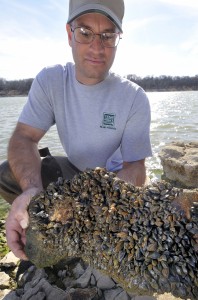Invasive Zebra Mussels May Have Finally Met Their Match

Max Faulkner/MCT/LANDOV
Texas Parks and Wildlife's Todd Robinson holds a rock covered with zebra mussels in Lake Texoma, Texas. The mollusk can stick to nearly anything, posing problems for power plants and fishing boats.
At first glance, zebra mussels appear harmless, perhaps even cute. But the tiny creatures are anything but cute for Texas lakes.
Originally from Eurasia, zebra mussels made their first appearance in North America in the Great Lakes in the early nineties. The mussels have since made their way to Texas, and over the years, this invasive species has proliferated in the state, killing off alarming numbers of native species and clogging pipes used for power plants, drinking water, manufacturing and boating. Now they may have finally met their match, in the form of microscopic bacteria.
Currently, zebra mussels are combated with several strategies, including chlorine and metal-based solutions, filtering systems and hot water. But none have proven capable of wiping them out.
“There is not one silver bullet that is effective in killing the mussels in all situations that won’t harm other species and keep our waters safe,” says Brian Van Zee, from the Texas Parks and Wildlife Department.
Now Texas is looking into an up-and-coming pesticide that attacks zebra mussels and zebra mussels alone.
Daniel Molloy, a research scientist at the State University of New York at Albany, created a bacterium that gave way to an environmentally safe pesticide called Zequanox. Once Marrone Bio Innovations — a bio-based pest management company located in California — finishes commercializing the product, companies in Texas may buy Zequanox to rid their pipes of the invasive mussel, without harming native species. “In fact, the warmer the water is, we have seen in our tests, the more effective the kill is,” Molloy says.

Photo courtesy of New York State Museum
Molloy’s environmentally friendly pesticide may bring relief to lakeside companies.
The drawback?
The Environmental Protection Agency (EPA) prohibits treatment of Zequanox in open water and “unconfined infrastructure.” This means fishing boats, marinas and pipes exposed to open waters are off limits for Zequanox.
The EPA only allows use of Zequanox in enclosed water infrastructure, such as water storage chambers of power plants, pump stations, irrigation systems, industrial and manufacturing facilities and dams.
“A lot of lake associations are hearing about this product called Zequanox and they say, ‘Hey, we want to get rid of them from our lakes,'” Molloy says. “And I go, ‘Wait a minute.'”
He says for financial and technical reasons, “there is nothing on the market today that can be used to eradicate — eliminate — zebra mussels from a lake.”
Molloy says the only documented case in the world of a water body successfully eradicated of zebra mussels took place in Virginia 12 years ago.
“They took a quarry several acres large and on private land, and they took this fresh water quarry and they converted it into a saltwater quarry by adding a salt,” Molloy says. “But there was no outlet to contaminate any rivers.”
Eliminating the invasive species from a water body may be rare and unfeasible, but Molloy says it may be possible in smaller, “high value areas like a beach or a marina.”
Van Zee, TPWD representative, says Zequanox is still in the “developing stages, but it looks promising” for Texas. The US Army Corps of Engineers is currently researching the product as well.
If it ends up working, perhaps one day zebra mussels in Texas will be a thing of the past.

